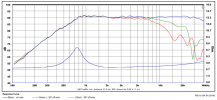Okay, now you say that untrained listeners can reconstruct the missing fundamentally in the brain only from four, trained from three harmonics.
I assume that the bet was about real existing headphones and loudspeakers, through which one should be able to hear the missing fundamentals.
If you insist on at least four harmonics, then you have already lost the bet, since there are very likely no speakers or headphones that still reproduce 75kHz with full SPL.
But fine, you insist on at least four harmonics,
then we'll do the whole test again. And to make it especially
easy to hear the missing fundamentals, I use 8kHz as the fundamental.
First, Octave is used to generate the corresponding sine tones. The fundamental at 8kHz and the 16kHz, 24kHz, 32kHz and 40kHz harmonics.
We also have the sum of all sine tones and the sum of all harmonics (missing fundamental) generated graphically:
View attachment 267217
Graphically, omitting the fundamental seems to make little difference, there are still peaks with the spacing of the fundamental.
Octave now generates once the sum of all tones (A) including the fundamental and once only the sum of the overtones (B).
To check that everything was generated the way we wanted it, five second long wav samples are compared in DeltaWave:
View attachment 267218
The white curve corresponds to B and the blue curve to A, i.e. with the fundamental at 8kHz. The sample files are perfect.
The sample files to reproduce the experiment are attached.
The test setup was, as usual, a tweeter capable of transmitting the full sound pressure level up to over 40kHz and a microphone to check that all sine tones are really transmitted as planned.
View attachment 267219 View attachment 267228
The measurements confirm that all frequencies are transmitted. If only the harmonics are measured, the measurements show that the 8kHz fundamental is reproduced with -40dB attenuation (the cause is not quite clear to me, but would facilitate the hearing of the fundamental, so no problem).
Above 30kHz the SPL of the measured sinusoidal tones drops slightly, the reason for this is most likely the mic.
In yellow is the measurement of all sine tones (A) and in green is the measurement without the fundamental (B).
View attachment 267222
I then played the test tones with the 8kHz fundamental (A) so loud that it was barely tolerable.
Then I played the sine tones without the fundamental (B) without changing any setting. There was dead silence, even when my ear moved dangerously close to the tweeter (sometimes thought I could perceive the 16kHz tone).
After all the tests, I would conclude that
@lashto clearly lost the bet. Even at 8kHz, the missing fundamental is no longer perceptible.

